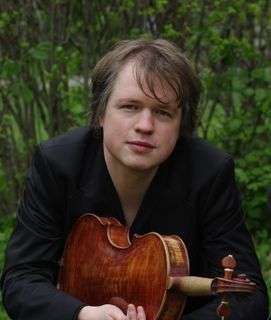|
Back
Bach To The Future New York
Isaac Stern Auditorium, Carnegie Hall
10/08/2009 -
Igor Stravinsky: Concerto in E-flat for Chamber Orchestra (“Dumbarton Oaks”)
J.S. Bach: Ricercare from Musical Offering, orchestrated by Anton Webern
Aaron Jay Kernis : Concerto with Echoes (World Premiere, commissioned by Orpheus as part of The New Brandenburg Project)
Ludwig van Beethoven: Violin Concerto in D Major, Opus 61
Henning Kraggerud (Violin)
Orpheus Chamber Orchestra 
H. Kraggerud (© Julia Serafin)
The opening three works for this first Orpheus Chamber Orchestra of the season were each influenced by Johann Sebastian Bach, though it is doubtful that the Cantor of Leipzig would have recognized too much of his own work. But for 21st Century listeners, these arrangements–overt and covert–were played with the precision and always interesting nuances which this great leader-less orchestra possesses.
Fitting for a season which will highlight Stravinsky, the Orpheus opened with a very bouncy “Dumbarton Oaks” Concerto, based not on a particular Brandenburg, but with solid counterpoint, constant movement, allegiance to all those jagged rhythms, and a few moments–like the glorious second-movement flute solo by Susan Palma-Nidel–giving a real lift. While the name was in honor of its patron, it can still bring back memories of the most glorious flower garden in all Georgetown.
More specific Bach was Webern’s classic orchestration of a Ricercare, which didn’t quite make the Orpheus standard. The solos (one basically for each note) were handled by the first-chair players, but the gorgeous tuttis were perhaps too well planned, lacking the neo-romatnic spontaneity which this rare Webern work possesses.
The Orpheus created their “Brandenburg Project” to give a 21st Century re-interpretation for Bach’s six gifts to a patron. (They were never played in his lifetime, and were hidden away for many decades.) Quite an original idea, and Mr. Kernis got the Sixth, which he pursued with unfettered joy.
Like the original, he did away with violins and other instruments (until the last movements), so that same dark flavor was apparent in the beginning. The first movement, in fact, would have been a test for a conducted orchestra. The Orpheus players take virtuosity for granted, so the whizzing whirling canons within canons were played with pinpoint accuracy.
That was a tribute to the orchestra. Mr. Kernis shone, though, in the final movements. The passacaglia was never devoid of emotion (one was thinking, pace, of Mr. Barber’s string Adagio), and rose up to a mighty system of chords with the help of brass, winds and timpani.
The third movement was not a letdown but a greater homage to the Bach of the suites. This was a gentle dance movement, a delightful bagatelle, as if Mr. Kernis was saying, “Now don’t expect me to be old Johann. I’m trying my best, but I think we should end with moments of placidity, so you don’t take me too seriously.”
The advertised soloist for the Beethoven Violin Concerto was Janine Jansen, but due to a sinus infection, her place was taken by the 30-something Norwegian violinist Henning Kraggerud. From the first bars on, it was obvious that he is a master of technique. But once into the first movement, it was equally obvious that he is different, from any violinist around today.
Mr. Kraggerud is that so unique musician who does not rely on fireworks, never comes near to histrionics, but plays with an understated lyricism. I use that word consciously, since his 1744 Guarnari not only had a bel canto tone, especially in the high registers, but he phrased the Concerto with the vocalism of a tasteful soprano.
Mr. Kraggerud’s confidence wasn’t arrogant or show-offy, but had the self-assurance of one who preferrred playing the notes at their finest rather than showing how deft he was with his instrument.
This combination of artistic modesty with technical assurance made one listen to Beethoven anew. But more was to come. The two cadenzas had a romantic veneer yet were never far from the original music. They were obviously difficult but not once did one feel that the artist was flaunting his fingerwork.
I guessed (and then confirmed) that by their structure and good taste, Mr. Kraggerud had written them himself. And with all the creative Bach arrangements and wondrous Orpheus ensemble playing, it was this allegiance to the original Beethoven notes which remains in the memory.
Harry Rolnick
|